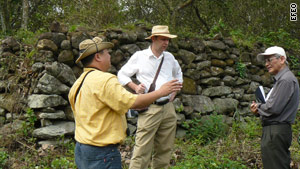 After five years of exploration and excavation, archaeologists from Hanoi’s École Française d’Extrême-Orient and the Vietnam Academy of Social Sciences have uncovered a 79 mile-long wall. The locals apparently call it “Vietnam’s Great Wall,” even though it’s far less imposing — it alternates masonry and earth ramparts, the highest parts of the wall reaching a mere four feet — and ancient.
After five years of exploration and excavation, archaeologists from Hanoi’s École Française d’Extrême-Orient and the Vietnam Academy of Social Sciences have uncovered a 79 mile-long wall. The locals apparently call it “Vietnam’s Great Wall,” even though it’s far less imposing — it alternates masonry and earth ramparts, the highest parts of the wall reaching a mere four feet — and ancient.
Built in the early 19th century under Emperor Gia Long of the Nguyen Dynasty, the Long Wall of Quang Ngai was built to demarcate the border between rival ethnic groups in Quang Ngai Province of central Vietnam. It reaches from northern Quang Ngai down south to Binh Dinh Province and is a prime candidate for the greatest feat of engineering of the Nguyen Dynasty.
Despite the locals’ nickname referencing the Great Wall of China, the Vietnam Wall is more like Hadrian’s Wall — a Roman-era wall on the border of England and Scotland.
Like Hadrian’s Wall, the Quang Ngai wall was built along a pre-existing road. More than 50 ancient forts have been identified along its length, established to maintain security and levy taxes. There is evidence to suggest that many of the forts, markets and temples built along the road are much older than the wall itself.
It served to demarcate territory and regulate trade and travel between the Viet in the plains and the Hrê tribes in the mountain valleys. Research suggests it may have been built in cooperation between both the Viet and the Hrê.
According to experts, the wall’s construction was in the interests of both communities, and inhabitants in both zones tell stories about how their respective ancestors built the wall to protect their territory from incursions by the other side.
Despite its relatively recent prominence, the wall became overgrown and unknown. Five years ago, Dr. Andrew Hardy, head of the Hanoi branch of École Française d’Extrême-Orient, found a reference to the wall in a geography report compiled by a Nguyen Dynasty courtier in 1885. Intrigued, he teamed up with Dr. Nguyen Tien Dong of the Vietnam Academy of Social Sciences and they put together the excavation project which has now borne fruit.
And it was the work of Emperor Gia Long, born Nguyễn Phúc Ánh, unifier of Vietnam, founder of the Nguyễn Dynasty, the last of the Vietnamese dynasties? Fascinating.